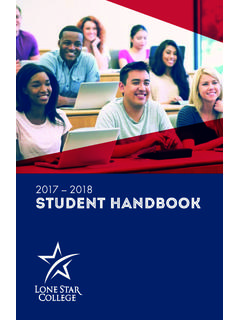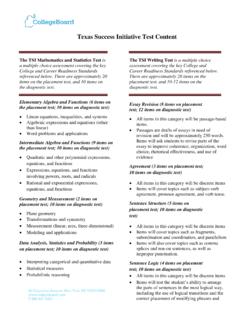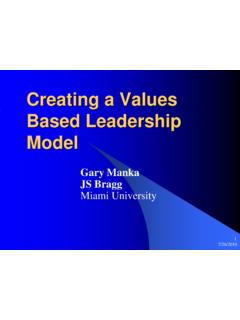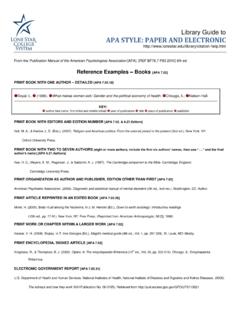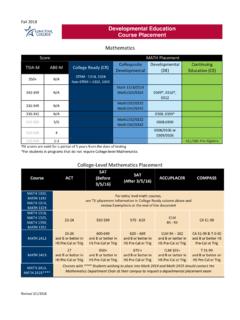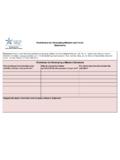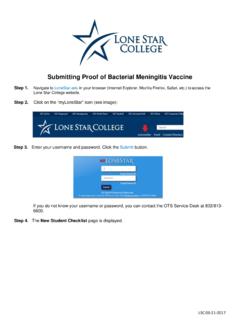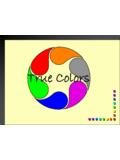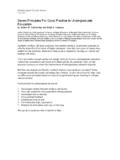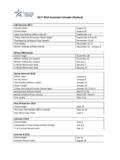Transcription of Data Dictionary - Lone Star College
1 data Dictionary LSC-Analytics and Institutional Reporting The first section of the data Dictionary contains definitions to be used in reports The second section contains more in depth definitions. Frequently Used Footnotes: Completion: Final grade given (student did not withdraw). Grades include A, B, C, D, P, NP, F, I, IP. Success: Final grade A, B, C or P. Success is calculated two ways. Percentage of students who completed course and percentage of students who enrolled in course. FTIC: First time in College (FTIC = Student with 0 credit hours at start of term.) Delivery Method: Defined by Instruction Mode of section taught: Face-to-Face = 'P' Online = 'OL' and 'W' Hybrid = 'PG','PL','PR','R','RG','RL','VG','VL',' WG','IV','WL, T' (Historical: Day, Evening, Weekend, Online, Hybrid) Dual Credit/Early College High School: Simultaneously completing a high school and College course for credit at both levels.
2 (Depending on cohort, data definitions may vary.) FTE: Full-time equivalent There are 2 methodologies that we use for calculating FTE. LSC Methodology = All credit hours/ 12 = FTE IPEDS Methodology = # Full-time students (# Part-time students x .335737) Headcount: Student is counted once at each campus. Total of all campuses equals system headcount. System total includes duplicates. Persistence: Percent of previous term unduplicated students who return to any LSC College or online program the following term. New as of 8/30/16 Fa-Sp persistence will exclude all Fall graduates Fa-Fa persistence will exclude all Fall, Spring and Summer graduates Sp-Fa persistence will exclude Spring and Summer graduates Sp-Sp persistence will exclude Spring, Summer and Fall graduates LSC-Analytics and Institutional Reporting data Dictionary Page 2 of 9 FERPA: List does not include students with limited disclosure of directory information under FERPA THECB definitions are italicized.
3 AA: Associate of Arts Degree An associate degree that will satisfy the lower-division requirements for a baccalaureate degree in a specific discipline. AAS: Associate of Applied Science Degree A two-year applied associate degree program designed to lead the recipient to immediate employment and/or career advancement. The program is composed of an orderly, identifiable sequence of courses designed to meet specific occupational competencies and outcomes. It includes technical courses, general education courses, related instruction, and, as appropriate, elective courses to prepare students for employment as technicians or professionals. A program of study designed for immediate employment and/or career advancement that is composed of an orderly, identifiable sequence of courses designed to meet specific occupational competencies and outcomes.
4 The degree program is composed of technical courses, general education courses, related instruction, and as, appropriate, elective courses to prepare students for employment as technicians or professionals. Minimum semester credit hours are 60, maximum is 72. AAT: Associate of Arts in Teaching Board-approved collegiate degree programs consisting of lower-division courses intended for transfer to baccalaureate programs that lead to initial Texas teacher certification. AS: Associate of Science Degree Academic Year: The 12-month period of time generally extending from September to August. Consists of a Fall, Spring, and Summer term. Academically Disadvantaged: When reporting academically disadvantaged students, colleges may report students who, based on a Texas Success Initiative (TSI) approved test, do not have College entry-level skills in reading, writing, or math.
5 Colleges should also report TSI compliant students who are enrolled in remedial courses based on the results of tests administered for placement purposes. The Interim Evaluation Report definition may also be applied for students who did not receive a high school diploma nor receive a GED certificate. Field will contain 1 if the student is academically disadvantaged. Please note that academically disadvantaged does not include students with learning disabilities. LSC-Analytics and Institutional Reporting data Dictionary Page 3 of 9 Accountability System: The Higher Education Accountability System is used to track performance on critical measures that exemplify higher education institutions' missions.
6 The system is modeled on the state's higher education plan, Closing the Gaps, by 2015. Its major focus is on the four Closing the Gaps target areas of participation, success, excellence, and research. ACCUPLACER: An approved academic skills assessment instrument that allows a student to satisfy one or more section(s) of the Texas Success Initiative (TSI) upon meeting the designated standard for that section or sections. It is offered by The College Board. Adjunct Faculty: Instructor whose primary position is anything other than FAC and/or has a status of anything other than Full-time. A person who holds a non-tenure-track appointment to the teaching staff of an institution. Adjunct faculty are generally part-time, with generally narrower expectations for involvement with the institution.
7 Hired as needed, with no guarantees as to continuation of employment. Reported as Other Faculty. Annual Headcount: The number of students enrolled in one or more courses with each student counted only once for the year. Assistant Professor: A faculty member of an institution of higher education who ranks above an instructor and below an associate professor and who is tenured or is on a tenure track. Associate Degree: An award that normally requires at least 2 but less than 4 years of full-time equivalent College work in a grouping of courses designed to lead the individual directly to employment in a specific career or to transfer to an upper-level baccalaureate program. This specifically refers to the associate of arts, associate of science, associate of applied arts, associate of applied science, associate of arts in teaching, and associate of occupational studies degrees.
8 The term applied in an associate degree name indicates a program in which the content is primarily technical. Award: The credential granted a student for successful completion of a set curriculum such as a degree or certificate. Carl D. Perkins Vocational and Technical Education Act of 1998 (Public Law ): A federal initiative to make the more competitive in the world economy by developing more fully the academic and occupational skills of all segments of the population principally through improving educational programs leading to academic, occupational, training, and re-training skill competencies needed to work in a technologically advanced society. Perkins funds for postsecondary initiatives are managed by the Coordinating Board and awarded annually.
9 LSC-Analytics and Institutional Reporting data Dictionary Page 4 of 9 CBM Reports: Coordinating Board Management reports that are mandatorily submitted to the Texas Higher Education Coordinating Board and are the basis for state reimbursement. CMB00A: Students in Continuing Education Courses Report CMB00C: Continuing Education Class Report CMB001: Student Report CMB002: Student Report of the Texas Success Initiative (TSI) CMB004: Class Report CMB006: End of Semester Report CMB009: Graduation Report CE: Continuing Education Certificate Program: A technical program designed for entry-level employment or for upgrading skills and knowledge within an occupation. Certificate programs serve as building blocks and exit points for AAS degree programs.
10 This award is approved by the CB at one of four levels, appears on the Workforce Program Clearinghouse Inventory, and is subject to the CB program evaluation process. CIP Code: Classification of Instructional Programs. The taxonomy for all levels of instructional programs, developed by the Department of Education s Center for Education Statistics. Clinical: Clinical experiences provide workplace settings in which students learn and apply program theory and management of the work flow. Clinical experiences must take place in a health care setting and students must not be paid for the learning experiences. Continuing Students: Those students who attended the previous term at any LSC location Cohort: A group of persons who share one or more particular statistical or demographic characteristics, such as having received their associate s degree in a certain year or range of years.
